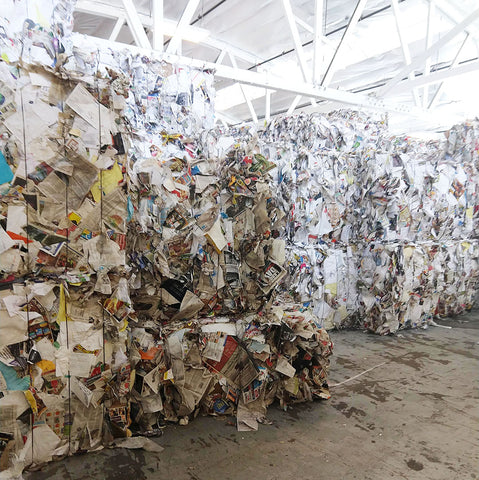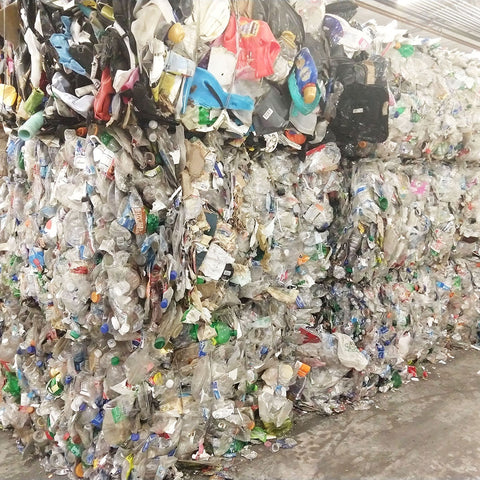Recycling is better than land-filling but not as good as reusing or reducing.
Paper, plastic, glass, and aluminum are recyclable.
The U.S. ships recyclable materials to China, but China recently stopped accepting stuff.
We all know these things about recycling, right? Many of us want to know more about the process, but the “out of sight, out of mind” nature of waste management makes it way too difficult to get the details. This is part one of a two-part series to demystify recycling.
This is the conveyor system at a sorting facility. There are a series of mechanisms for sorting out various materials that come in at different steps in the process: compressed air may be used to sort paper, magnets may be used for metals, optical systems may be used to separate different types of plastic, and there are even humans doing some of the work manually.
Humans often scope out the material before it enters the automated sorting system to pull out items like plastic bags. If you dispose of your recyclables in a plastic bag, there is a human making a quick judgment call about whether they should empty the bag or send it to the landfill. If it’s a heavy bag, they might opt to toss it. If you want to be sure that your recyclables get recycled, skip the bag!
Metals
What’s recyclable | Aluminum cans, steel and tin cans, aluminum foil (just clean it before you toss it in the bin)
Recycling process | Metals are shredded and washed, melted, poured into molds, shipped to another facility, melted into sheets, then shipped to manufacturers for reuse.

Recovery markets | Food storage, medical instruments, cookware, construction supplies
How many times can it be recycled | Indefinitely! Metals are 100% recyclable and do not downgrade in quality during the recycling process!
Energy savings in recycling versus using raw material | Recycling steel uses 75% less energy than using raw materials.
Room for improvement | Only 50% of discarded aluminum is recycled.
Paper
What’s recyclable | Cardboard, paper board, newspaper and magazines, printer paper
Recycling process | Paper is shredded, mixed with water to create pulp, washed and bleached, pressed, rolled, then shipped to manufacturers for reuse.
Recovery markets | Cereal boxes, egg cartons, cardboard, toilet paper
How many times can it be recycled | Paper can be recycled 4 to 6 times before fibers are too shortened and weakened for re-use.
Energy savings in recycling versus using raw material | Recycling paper and cardboard uses 65 to 75% less energy than creating paper and cardboard from virgin materials.
Room for improvement | Between 42% and 63% of paper is recycled in the U.S.
Glass
What’s recyclable | Glass bottles and jars
Recycling process | Glass is broken down into small pieces (“cullets”), sorted, cleaned, and melted. Some processes require that glass be sorted by color, since it maintains its color after recycling.
Recovery markets | Glass bottles and jars, concrete, abrasives, water filtration
How many times can it be recycled | Indefinitely! Glass does not degrade in quality during the recycling process!
Energy savings in recycling versus using raw material | Recycling glass uses up to 30% less energy than creating a glass product from raw materials.
Room for improvement | Even though recyclable glass is 100% recoverable, U.S. bottles and jars only contain about 27% of recycled glass.
Plastic
What’s recyclable | “Bottles, jars, and jugs”
Recycling process | Plastics are sorted by type, shredded, washed, melted, shaped into pellets, then shipped to manufacturers for reuse.
Recovery markets | Office supplies, flooring, building insulation, garden accessories, CD cases
How many times can it be recycled | Plastic can be recycled 2 to 3 times before its polymer chain is too short, and its quality too diminished.
Energy savings in recycling versus using raw material | Recycling plastics uses 80 to 90% less energy than creating products from virgin materials.
Room for improvement | 91% of plastic is not recycled.
Plastic is often sorted from other recyclable materials using light technology. While most plastics reflect light, black plastic absorbs light, making it undetectable by the sorting system. For this reason, many local authorities instruct residents to send black plastic to landfill, since it will likely end up there either way.
What’s all this about China?
In 2018 China banned select solid waste imports as a measure to protect environmental and human health. Before the ban, China was accepting 45% of the world’s plastics, and about 31% of all of the U.S.’s recyclables.
As a direct result of the ban, many cities across the U.S. have discontinued curbside recycling programs, closed drop-off locations, or restricted the items accepted for recycling, meaning that previously exportable recyclables are being sent to the landfill. Waste management service providers across the U.S. have also increased prices for cities and residents.
Find out how the ban has impacted your home state at WasteDive.com.
What can you do about it?
89% of exported plastics are single-use food packaging. Avoid single-use food packaging by shopping in bulk and bringing your own food containers when you order food “to-go.”
According to National Geographic, the ban will displace over 100 million metric tons of plastic waste, and even before the plastic ban, as much as 12 million metric tons of plastic trash made its way into the ocean each year. Help keep the ocean clean by reducing your own plastic use, and participate in, or organize, a community clean-up.
Final Takeaways
Plastic and paper are only finitely recyclable. For that reason, virgin raw materials are often introduced in the recycling process. This is not a closed-loop system, so we should avoid single-use or limited-use products made from these materials.
If you use a plastic bin liner for your recyclables, this might indicate to the sorter at the recycling facility that your recyclables are contaminated with trash, and they might send the whole load to the landfill. Skip the bag!
Black plastics are likely to end up in the landfill even if you drop them in the recycling bin. Avoid black plastics whenever possible!
Avoiding single-use food packaging is one of the many ways you can help alleviate the new waste disposal burdens resulting from China embargoes.



